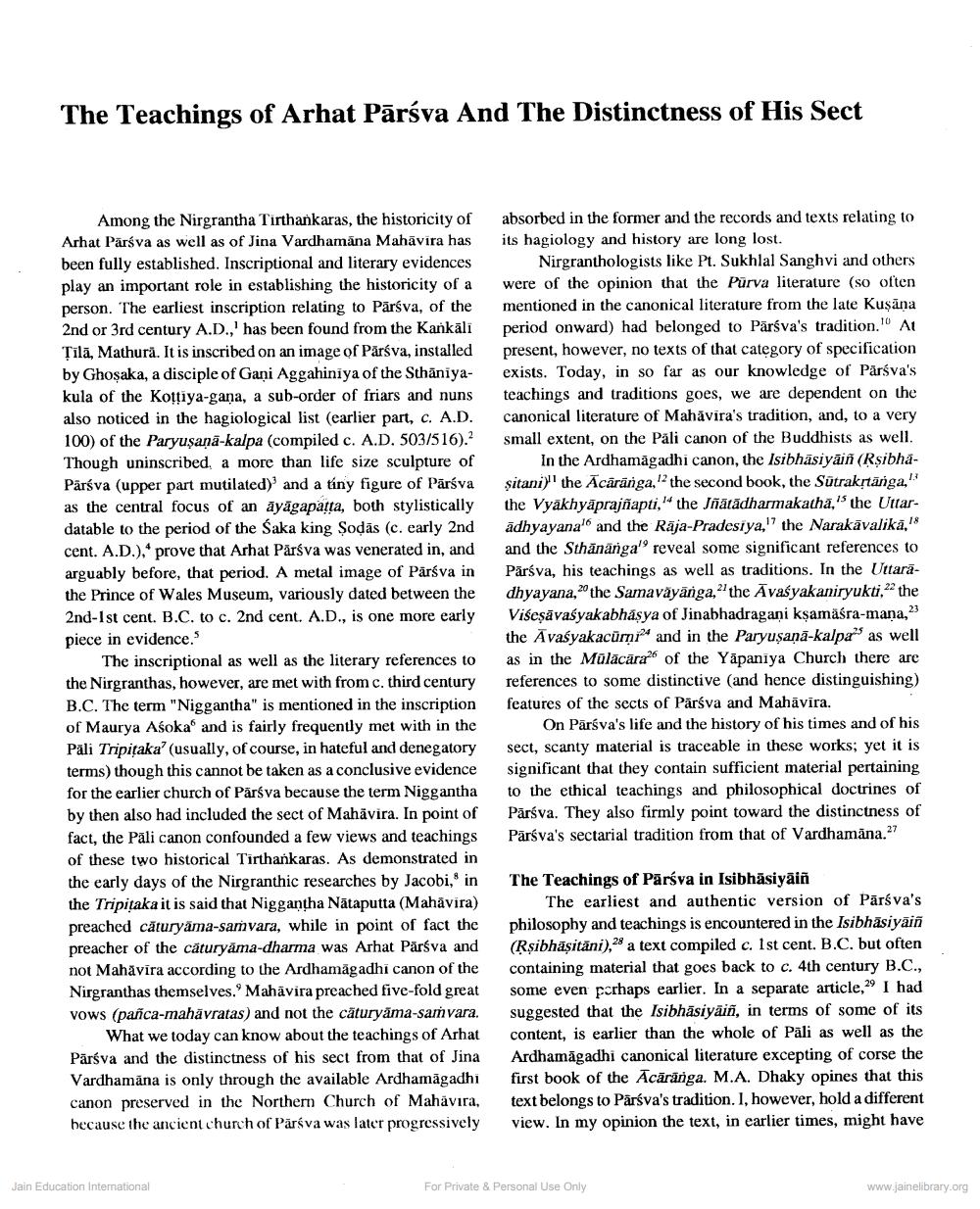________________
The Teachings of Arhat Pārśva And The Distinctness of His Sect
Among the Nirgrantha Tirthankaras, the historicity of Arhat Pārśva as well as of Jina Vardhamana Mahavira has been fully established. Inscriptional and literary evidences play an important role in establishing the historicity of a person. The earliest inscription relating to Pārsva, of the 2nd or 3rd century A.D.,' has been found from the Kankāli Tilā, Mathura. It is inscribed on an image of Pārsva, installed by Ghosaka, a disciple of Gani Aggahiniya of the Sthaniya- kula of the Kottiya-gana, a sub-order of friars and nuns also noticed in the hagiological list (earlier part, c. A.D. 100) of the Paryusana-kalpa (compiled c. A.D. 503/516).2 Though uninscribed, a more than life size sculpture of Pärśva (upper part mutilated) and a tiny figure of Pärśva as the central focus of an ayāgapatta, both stylistically datable to the period of the Saka king Sodās (c. early 2nd cent. A.D.),prove that Arhat Pärśva was venerated in, and arguably before, that period. A metal image of Parsva in the Prince of Wales Museum, variously dated between the 2nd-1st cent. B.C. to c. 2nd cent. A.D., is one more early piece in evidence."
The inscriptional as well as the literary references to the Nirgranthas, however, are met with from c. third century B.C. The term "Niggantha" is mentioned in the inscription of Maurya Asoka and is fairly frequently met with in the Pali Tripitaka' (usually, of course, in hateful and denegatory terms) though this cannot be taken as a conclusive evidence for the earlier church of Pārsva because the term Niggantha by then also had included the sect of Mahävira. In point of fact, the Pāli canon confounded a few views and teachings of these two historical Tirthankaras. As demonstrated in the early days of the Nirgranthic researches by Jacobi, in the Tripitaka it is said that Niggantha Nātaputta (Mahavira) preached căturyäma-samvara, while in point of fact the preacher of the căturyama-dharma was Arhat Pärśva and not Mahāvīra according to the Ardhamāgadhi canon of the Nirgranthas themselves.' Mahāvira preached five-fold great vows (pañca-mahävratas) and not the cäturyama-samvara.
What we today can know about the teachings of Arhat Pārýva and the distinctness of his sect from that of Jina Vardhamana is only through the available Ardhamāgadhi canon preserved in the Northern Church of Mahavira, hecause the ancient church of Päráva was later progressively
absorbed in the former and the records and texts relating to its hagiology and history are long lost.
Nirgranthologists like Pt. Sukhlal Sanghvi and others were of the opinion that the Purva literature (so often mentioned in the canonical literature from the late Kuşāna period onward) had belonged to Pārsva's tradition. At present, however, no texts of that category of specification exists. Today, in so far as our knowledge of Parsva's teachings and traditions goes, we are dependent on the canonical literature of Mahavira's tradition, and, to a very small extent, on the Pali canon of the Buddhists as well.
In the Ardhamāgadhi canon, the Isibhäsiyāin (Rşibhasitani) the Acārānga,' the second book, the Sütrakrtānga, the Vyakhyaprajñapti," the Jñärädharmakatha,' the Uttaradhyayana' and the Rāja-Pradesiya," the Narakāvalikā," and the Sthānanga' reveal some significant references to Pärśva, his teachings as well as traditions. In the Uttaradhyayana," the Samavayanga," the Avasyakaniryukti 22 the Viseşāvasyakabhâsya of Jinabhadragani kşamaśra-mana, 25 the Avasyakacürnr" and in the Paryusanā-kalpa” as well as in the Mülācāras of the Yapaniya Church there are references to some distinctive (and hence distinguishing) features of the sects of Pārśva and Mahāvīra.
On Pärśva's life and the history of his times and of his sect, scanty material is traceable in these works; yet it is significant that they contain sufficient material pertaining to the ethical teachings and philosophical doctrines of Pārsva. They also firmly point toward the distinctness of Pārsva's sectarial tradition from that of Vardhamāna.27
The Teachings of Pārśva in Isibhāsiyāin
The earliest and authentic version of Pārsva's philosophy and teachings is encountered in the Isibhāsiyain (Rşibhăşităni),28 a text compiled c. Ist cent. B.C. but often containing material that goes back to c. 4th century B.C., some even perhaps earlier. In a separate article,29 I had suggested that the Isibhāsiyāiñ, in terms of some of its content, is earlier than the whole of Pali as well as the Ardhamăgadhi canonical literature excepting of corse the first book of the Acārārga. M.A. Dhaky opines that this text belongs to Pärsva's tradition. I, however, hold a different view. In my opinion the text, in earlier times, might have
Jain Education International
For Private & Personal Use Only
www.jainelibrary.org




